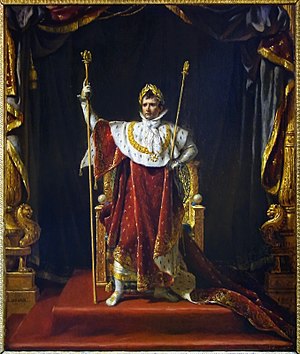
Napoleon in Imperial Costume was an 1805 portrait of Napoleon I in his coronation robes by Jacques-Louis David. Originally intended for the Tribuna in Genoa, Napoleon was unhappy with it and it was left incomplete. It is known via a small oil sketch now in the Palais des beaux-arts de Lille.
Another version of the same subject was meant for Napoleon's brother Jérôme Bonaparte, king of Westphalia. It is now lost, but known via a copy attributed to Rouget now in the Fogg Art Museum, an incomplete canvas attributed to Sebastian Weygandt in the Staatliche Kunstsammlungen in Kassel and a head study in the bibliothèque Thiers.